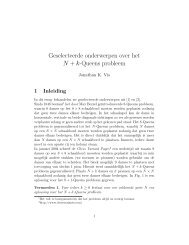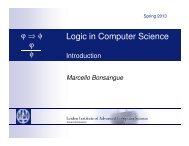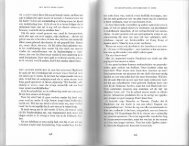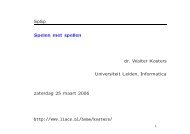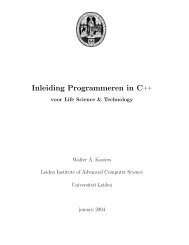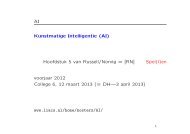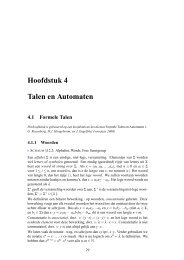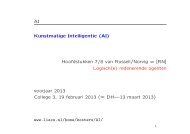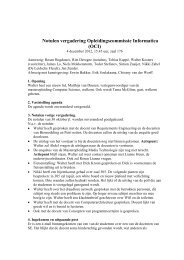Data Mining: Concepts and Techniques - LIACS
Data Mining: Concepts and Techniques - LIACS
Data Mining: Concepts and Techniques - LIACS
You also want an ePaper? Increase the reach of your titles
YUMPU automatically turns print PDFs into web optimized ePapers that Google loves.
<strong>Data</strong> <strong>Mining</strong>:<br />
<strong>Concepts</strong> <strong>and</strong> <strong>Techniques</strong><br />
— Chapter 4 —<br />
Jiawei Han<br />
Department of Computer Science<br />
University of Illinois at Urbana-Champaign<br />
www.cs.uiuc.edu/~hanj<br />
©2006 Jiawei Han <strong>and</strong> Micheline Kamber, All rights reserved<br />
11/02/10 <strong>Data</strong> <strong>Mining</strong>: <strong>Concepts</strong> <strong>and</strong> <strong>Techniques</strong> 1
Sales <strong>Data</strong> Cube:<br />
time,item<br />
A Short Recap on <strong>Data</strong> Cubes<br />
<strong>Data</strong> Cube: A Lattice of Cuboids<br />
all<br />
time item location supplier<br />
time,location<br />
time,supplier<br />
time,item,location<br />
time,item,supplier<br />
item,location<br />
time,location,supplier<br />
time, item, location, supplier<br />
item,supplier<br />
item,location,supplier<br />
location,supplier<br />
0-D(apex) cuboid<br />
1-D cuboids<br />
2-D cuboids<br />
3-D cuboids<br />
4-D(base) cuboid<br />
11/02/10 <strong>Data</strong> <strong>Mining</strong>: <strong>Concepts</strong> <strong>and</strong> <strong>Techniques</strong> 2
Multidimensional <strong>Data</strong><br />
Sales volume as a function of product, month,<br />
<strong>and</strong> region<br />
Product Region<br />
Month<br />
Dimensions: Product, Location, Time<br />
Hierarchical summarization paths<br />
summarize<br />
Industry Region Year<br />
Category Country Quarter<br />
Product City Month Week<br />
Office Day<br />
11/02/10 <strong>Data</strong> <strong>Mining</strong>: <strong>Concepts</strong> <strong>and</strong> <strong>Techniques</strong> 3
time<br />
time_key<br />
day<br />
day_of_the_week<br />
month<br />
quarter<br />
year<br />
branch<br />
branch_key<br />
branch_name<br />
branch_type<br />
Example of Star Schema<br />
Measures<br />
Sales Fact Table<br />
time_key<br />
item_key<br />
branch_key<br />
location_key<br />
units_sold<br />
dollars_sold<br />
avg_sales<br />
item<br />
item_key<br />
item_name<br />
br<strong>and</strong><br />
type<br />
supplier_type<br />
location<br />
location_key<br />
street<br />
city<br />
state_or_province<br />
country<br />
11/02/10 <strong>Data</strong> <strong>Mining</strong>: <strong>Concepts</strong> <strong>and</strong> <strong>Techniques</strong> 4
Total sales of TV’s in 1 st quarter in USA<br />
TV<br />
PC<br />
VCR<br />
sum<br />
Product<br />
Total sales in<br />
USA in 1Qtr<br />
A Sample <strong>Data</strong> Cube<br />
Date<br />
1Qtr 2Qtr 3Qtr 4Qtr<br />
2-D Cuboid<br />
1-D Cuboid<br />
3-D Cuboid<br />
sum<br />
0-D Cuboid<br />
Total annual sales<br />
of TV in U.S.A.<br />
U.S.A<br />
Canada<br />
Mexico<br />
11/02/10 <strong>Data</strong> <strong>Mining</strong>: <strong>Concepts</strong> <strong>and</strong> <strong>Techniques</strong> 5<br />
sum<br />
Country
Typical OLAP Operations<br />
Dice<br />
Slice<br />
Pivot<br />
Roll-up<br />
Drill-down<br />
11/02/10 <strong>Data</strong> <strong>Mining</strong>: <strong>Concepts</strong> <strong>and</strong> <strong>Techniques</strong> 6
Cuboids Corresponding to the Cube<br />
all<br />
product date country<br />
product,date product,country date, country<br />
product, date, country<br />
0-D(apex) cuboid<br />
1-D cuboids<br />
2-D cuboids<br />
3-D(base) cuboid<br />
11/02/10 <strong>Data</strong> <strong>Mining</strong>: <strong>Concepts</strong> <strong>and</strong> <strong>Techniques</strong> 7
<strong>Data</strong> Cubes: Ancestor – Descendent relation<br />
all<br />
product date country<br />
product,date product,country date, country<br />
No Parent/Ancestor –<br />
Child/Descendant relation!<br />
Ancestor<br />
(*,*,*,11540)<br />
(TV,*,US,300)<br />
Parent/Ancestor<br />
product, date, country<br />
(TV,January,US,45)<br />
Child/Descendant<br />
Ancestor<br />
(*,*,US,1200)<br />
0-D(apex) cuboid<br />
1-D cuboids<br />
2-D cuboids<br />
3-D(base) cuboid<br />
11/02/10 <strong>Data</strong> <strong>Mining</strong>: <strong>Concepts</strong> <strong>and</strong> <strong>Techniques</strong> 8
Chapter 4: <strong>Data</strong> Cube Computation<br />
<strong>and</strong> <strong>Data</strong> Generalization<br />
Efficient Computation of <strong>Data</strong> Cubes<br />
Exploration <strong>and</strong> Discovery in Multidimensional<br />
<strong>Data</strong>bases<br />
Attribute-Oriented Induction ─ An Alternative<br />
<strong>Data</strong> Generalization Method<br />
11/02/10 <strong>Data</strong> <strong>Mining</strong>: <strong>Concepts</strong> <strong>and</strong> <strong>Techniques</strong> 9
Efficient Computation of <strong>Data</strong> Cubes<br />
Preliminary cube computation tricks (Agarwal et al.’96)<br />
Computing full/iceberg cubes: 3 methodologies<br />
Top-Down: Multi-Way array aggregation (Zhao, Deshp<strong>and</strong>e &<br />
Naughton, SIGMOD’97)<br />
Bottom-Up:<br />
Bottom-up computation: BUC (Beyer & Ramarkrishnan,<br />
SIGMOD’99)<br />
H-cubing technique (Han, Pei, Dong & Wang: SIGMOD’01)<br />
Integrating Top-Down <strong>and</strong> Bottom-Up:<br />
Star-cubing algorithm (Xin, Han, Li & Wah: VLDB’03)<br />
High-dimensional OLAP: A Minimal Cubing Approach (Li, et al.<br />
VLDB’04)<br />
Computing alternative kinds of cubes:<br />
Partial cube, closed cube, approximate cube, etc.<br />
11/02/10 <strong>Data</strong> <strong>Mining</strong>: <strong>Concepts</strong> <strong>and</strong> <strong>Techniques</strong> 10
Iceberg Cube<br />
Computing only the cuboid cells whose<br />
count or other aggregates satisfying the<br />
condition like<br />
Motivation<br />
HAVING COUNT(*) >= minsup<br />
Only a small portion of cube cells may be “above the<br />
water’’ in a sparse cube<br />
Only calculate “interesting” cells—data above certain<br />
threshold<br />
Avoid explosive growth of the cube<br />
Suppose 100 dimensions, only 1 base cell. How many<br />
aggregate cells if count >= 1? What about count >= 2?<br />
11/02/10 <strong>Data</strong> <strong>Mining</strong>: <strong>Concepts</strong> <strong>and</strong> <strong>Techniques</strong> 11
Iceberg Cube<br />
Computing only the cuboid cells whose<br />
count or other aggregates satisfying the<br />
condition like<br />
HAVING COUNT(*) >= minsup<br />
compute cube sales_iceberg as<br />
select month, city, customer_group, count(*)<br />
from salesinfo<br />
cube by month, city, customer_group<br />
having count(*) >= minsup<br />
11/02/10 <strong>Data</strong> <strong>Mining</strong>: <strong>Concepts</strong> <strong>and</strong> <strong>Techniques</strong> 12
Closed Cubes<br />
<strong>Data</strong>base of 100 dimensions has 2 base cells:<br />
{(a 1 ,a 2 ,a 3 …, a 100 ): 10, (a 1 ,a 2 ,b 3 , …, b 100 ): 10}<br />
⇒ 2 101 -6 not so interesting aggregate cells:<br />
{(a 1 ,a 2 ,a 3 ,…,a 99 ,*): 10, (a 1 ,a 2 ,*,a 4 ,…, a 100 ): 10, …,<br />
(a 1 ,a 2 ,a 3 *,…, *): 10}<br />
The only 3 interesting aggregate cells would be:<br />
{(a1 ,a2 ,a3 …, a100 ): 10, {(a1 ,a2 ,b3 …, b100 ): 10,<br />
(a1 ,a2 ,*, …, *): 20}<br />
11/02/10 <strong>Data</strong> <strong>Mining</strong>: <strong>Concepts</strong> <strong>and</strong> <strong>Techniques</strong> 13
Closed Cubes<br />
A cell c, is a closed cell, if there exists no cell d<br />
such that d is a specialization (descendant) of cell<br />
c (i.e., replacing a * in c with a non-* value), <strong>and</strong> d has<br />
the same measure value as c (i.e., d will have strictly<br />
smaller measure value than c).<br />
A closed cube is a data cube consisting of only<br />
closed cells.<br />
For example the previous three form a lattice of<br />
closed cells for a closed cube.<br />
11/02/10 <strong>Data</strong> <strong>Mining</strong>: <strong>Concepts</strong> <strong>and</strong> <strong>Techniques</strong> 14
Closed cube lattice:<br />
Closed Cubes<br />
(a 1 ,a 2 ,*, …, *): 20<br />
(a 1 ,a 2 ,a 3 , …, a 100 ): 10 (a1,a2,b 3 , …, b 100 ): 10<br />
11/02/10 <strong>Data</strong> <strong>Mining</strong>: <strong>Concepts</strong> <strong>and</strong> <strong>Techniques</strong> 15
Preliminary Tricks (Agarwal et al. VLDB’96)<br />
Sorting, hashing, <strong>and</strong> grouping operations are applied to the dimension<br />
attributes in order to reorder <strong>and</strong> cluster related tuples<br />
Aggregates may be computed from previously computed aggregates,<br />
rather than from the base fact table<br />
Smallest-child: computing a cuboid from the smallest, previously<br />
computed cuboid<br />
Cache-results: caching results of a cuboid from which other<br />
cuboids are computed to reduce disk I/Os<br />
Amortize-scans: computing as many as possible cuboids at the<br />
same time to amortize disk reads<br />
Share-sorts: sharing sorting costs cross multiple cuboids when a<br />
sort-based method is used<br />
Share-partitions: sharing the partitioning cost across multiple<br />
cuboids when hash-based algorithms are used<br />
11/02/10 <strong>Data</strong> <strong>Mining</strong>: <strong>Concepts</strong> <strong>and</strong> <strong>Techniques</strong> 16
Multi-Way Array Aggregation<br />
Array-based “bottom-up” algorithm<br />
Using multi-dimensional chunks<br />
No direct tuple comparisons<br />
Simultaneous aggregation on<br />
multiple dimensions<br />
Intermediate aggregate values are<br />
re-used for computing ancestor<br />
cuboids<br />
Cannot do Apriori pruning: No<br />
iceberg optimization<br />
11/02/10 <strong>Data</strong> <strong>Mining</strong>: <strong>Concepts</strong> <strong>and</strong> <strong>Techniques</strong> 17<br />
all<br />
A B<br />
AB<br />
C<br />
AC BC<br />
ABC
B<br />
Multi-way Array Aggregation for Cube<br />
Computation (MOLAP)<br />
Partition arrays into chunks (a small subcube which fits in memory).<br />
Compressed sparse array addressing: (chunk_id, offset)<br />
Compute aggregates in “multiway” by visiting cube cells in the order<br />
which minimizes the # of times to visit each cell, <strong>and</strong> reduces<br />
memory access <strong>and</strong> storage cost.<br />
C<br />
c3 61 62 63 64<br />
c2 45 46 47 48<br />
c1<br />
c 0<br />
29 30 31 32<br />
b3 B13<br />
b2 9<br />
b1 5<br />
b0 1<br />
14<br />
2<br />
15<br />
3<br />
16<br />
4<br />
60<br />
44<br />
28<br />
56<br />
40<br />
24<br />
52<br />
36<br />
20<br />
a0<br />
a1<br />
A<br />
a2 a3<br />
What is the best<br />
traversing order<br />
to do multi-way<br />
aggregation?<br />
11/02/10 <strong>Data</strong> <strong>Mining</strong>: <strong>Concepts</strong> <strong>and</strong> <strong>Techniques</strong> 18
Multi-way Array Aggregation for<br />
Cube Computation<br />
B<br />
C<br />
c3 61 62 63 64<br />
c2 45 46 47 48<br />
c1<br />
c 0<br />
29 30 31 32<br />
b3<br />
b2<br />
b1<br />
b0<br />
B13<br />
9<br />
5<br />
1<br />
14<br />
2<br />
15<br />
3<br />
16<br />
4<br />
60<br />
44<br />
28<br />
56<br />
40<br />
24<br />
52<br />
36<br />
20<br />
a0<br />
a1<br />
A<br />
a2 a3<br />
11/02/10 <strong>Data</strong> <strong>Mining</strong>: <strong>Concepts</strong> <strong>and</strong> <strong>Techniques</strong> 19
Multi-way Array Aggregation for<br />
Cube Computation<br />
B<br />
C<br />
c3 61 62 63 64<br />
c2 45 46 47 48<br />
c1<br />
c 0<br />
29 30 31 32<br />
b3<br />
b2<br />
b1<br />
b0<br />
B13<br />
9<br />
5<br />
1<br />
14<br />
2<br />
15<br />
3<br />
16<br />
4<br />
60<br />
44<br />
28<br />
56<br />
40<br />
24<br />
52<br />
36<br />
20<br />
a0<br />
a1<br />
A<br />
a2 a3<br />
11/02/10 <strong>Data</strong> <strong>Mining</strong>: <strong>Concepts</strong> <strong>and</strong> <strong>Techniques</strong> 20
Multi-Way Array Aggregation for<br />
Cube Computation (Cont.)<br />
Method: the planes should be sorted <strong>and</strong> computed<br />
according to their size in ascending order<br />
Idea: keep the smallest plane in the main memory,<br />
fetch <strong>and</strong> compute only one chunk at a time for the<br />
largest plane<br />
Limitation of the method: computing well only for a small<br />
number of dimensions<br />
If there are a large number of dimensions, “top-down”<br />
computation <strong>and</strong> iceberg cube computation methods<br />
can be explored<br />
11/02/10 <strong>Data</strong> <strong>Mining</strong>: <strong>Concepts</strong> <strong>and</strong> <strong>Techniques</strong> 21
Bottom-Up Computation (BUC)<br />
BUC (Beyer & Ramakrishnan,<br />
SIGMOD’99)<br />
Bottom-up cube computation<br />
(Note: top-down in our view!)<br />
Divides dimensions into partitions<br />
<strong>and</strong> facilitates iceberg pruning<br />
If a partition does not satisfy<br />
min_sup, its descendants can<br />
be pruned<br />
If minsup = 1 ⇒ compute full<br />
CUBE!<br />
No simultaneous aggregation<br />
5 ABCD<br />
11/02/10 <strong>Data</strong> <strong>Mining</strong>: <strong>Concepts</strong> <strong>and</strong> <strong>Techniques</strong> 22<br />
AB<br />
all<br />
A B C<br />
AC AD BC BD CD<br />
ABC ABD ACD BCD<br />
3 AB<br />
ABCD<br />
1 all<br />
2 A 10 B 14 C<br />
7 AC 9 AD 11 BC 13 BD 15 CD<br />
4 ABC 6 ABD 8 ACD 12 BCD<br />
D<br />
16 D
BUC: Partitioning<br />
Usually, entire data set can’t fit in main<br />
memory<br />
Sort distinct values, partition into blocks that fit<br />
Continue processing<br />
Optimizations<br />
Partitioning<br />
External Sorting, Hashing, Counting Sort<br />
Ordering dimensions to encourage pruning<br />
Cardinality, Skew, Correlation<br />
Collapsing duplicates<br />
Can’t do holistic aggregates anymore!<br />
11/02/10 <strong>Data</strong> <strong>Mining</strong>: <strong>Concepts</strong> <strong>and</strong> <strong>Techniques</strong> 23
H-Cubing: Using H-Tree Structure<br />
Bottom-up computation<br />
Exploring an H-tree<br />
structure<br />
If the current<br />
computation of an H-tree<br />
cannot pass min_sup, do<br />
not proceed further<br />
(pruning)<br />
No simultaneous<br />
aggregation<br />
11/02/10 <strong>Data</strong> <strong>Mining</strong>: <strong>Concepts</strong> <strong>and</strong> <strong>Techniques</strong> 24<br />
AB<br />
all<br />
A B C<br />
AC AD BC BD CD<br />
ABC ABD ACD BCD<br />
ABCD<br />
D
Header<br />
table<br />
Month<br />
Jan<br />
Jan<br />
Jan<br />
Feb<br />
Mar<br />
…<br />
Attr. Val.<br />
Edu<br />
Hhd<br />
Bus<br />
…<br />
Jan<br />
Feb<br />
…<br />
Tor<br />
Van<br />
Mon<br />
…<br />
City<br />
Tor<br />
Tor<br />
Tor<br />
Mon<br />
Van<br />
…<br />
H-tree: A Prefix Hyper-tree<br />
Cust_grp<br />
Edu<br />
Hhd<br />
Edu<br />
Bus<br />
Edu<br />
…<br />
Quant-Info<br />
Sum:2285 …<br />
…<br />
…<br />
…<br />
…<br />
…<br />
…<br />
…<br />
…<br />
…<br />
…<br />
Prod<br />
Printer<br />
TV<br />
Camera<br />
Laptop<br />
HD<br />
…<br />
Cost<br />
500<br />
800<br />
1160<br />
1500<br />
540<br />
…<br />
Side-link<br />
Price<br />
485<br />
1200<br />
1280<br />
2500<br />
520<br />
…<br />
11/02/10 <strong>Data</strong> <strong>Mining</strong>: <strong>Concepts</strong> <strong>and</strong> <strong>Techniques</strong> 25<br />
bins<br />
root<br />
edu hhd bus<br />
Jan Mar Jan Feb<br />
Tor Van Tor Mon<br />
Quant-Info<br />
Sum: 1765<br />
Cnt: 2<br />
Q.I. Q.I.<br />
Q.I.
H-Cubing: Computing Cells Involving Dimension City<br />
Header<br />
Table<br />
H Tor<br />
Attr. Val.<br />
Edu<br />
Hhd<br />
Bus<br />
…<br />
Jan<br />
Feb<br />
…<br />
Tor<br />
Van<br />
Mon<br />
…<br />
Attr. Val.<br />
Edu<br />
Hhd<br />
Bus<br />
…<br />
Jan<br />
Feb<br />
…<br />
Quant-Info<br />
Sum:2285 …<br />
…<br />
…<br />
…<br />
…<br />
…<br />
…<br />
…<br />
…<br />
…<br />
…<br />
Q.I.<br />
…<br />
…<br />
…<br />
…<br />
…<br />
…<br />
…<br />
Side-link<br />
Side-link<br />
From (*, *, Tor) to (*, Jan, Tor)<br />
11/02/10 <strong>Data</strong> <strong>Mining</strong>: <strong>Concepts</strong> <strong>and</strong> <strong>Techniques</strong> 26<br />
bins<br />
root<br />
Edu. Hhd. Bus.<br />
Jan. Mar. Jan. Feb.<br />
Tor. Van. Tor. Mon.<br />
Quant-Info<br />
Sum: 1765<br />
Cnt: 2<br />
Q.I. Q.I.<br />
Q.I.
Computing Cells Involving Month But No City<br />
1. Roll up quant-info<br />
2. Compute cells involving<br />
month but no city<br />
Attr. Val.<br />
Edu.<br />
Hhd.<br />
Bus.<br />
…<br />
Jan.<br />
Feb.<br />
Mar.<br />
…<br />
Tor.<br />
Van.<br />
Mont.<br />
…<br />
Quant-Info<br />
Sum:2285 …<br />
…<br />
…<br />
…<br />
…<br />
…<br />
…<br />
…<br />
…<br />
…<br />
…<br />
…<br />
Side-link<br />
11/02/10 <strong>Data</strong> <strong>Mining</strong>: <strong>Concepts</strong> <strong>and</strong> <strong>Techniques</strong> 27<br />
root<br />
Edu. Hhd. Bus.<br />
Jan. Mar. Jan. Feb.<br />
Q.I.<br />
Q.I. Q.I.<br />
Q.I.<br />
Tor. Van. Tor. Mont.<br />
Top-k OK mark: if Q.I. in a child passes<br />
top-k avg threshold, so does its parents.<br />
No binning is needed!
Computing Cells Involving Only Cust_grp<br />
Check header table directly<br />
Attr. Val.<br />
Edu<br />
Hhd<br />
Bus<br />
…<br />
Jan<br />
Feb<br />
Mar<br />
…<br />
Tor<br />
Van<br />
Mon<br />
…<br />
Quant-Info<br />
Sum:2285 …<br />
…<br />
…<br />
…<br />
…<br />
…<br />
…<br />
…<br />
…<br />
…<br />
…<br />
…<br />
Side-link<br />
11/02/10 <strong>Data</strong> <strong>Mining</strong>: <strong>Concepts</strong> <strong>and</strong> <strong>Techniques</strong> 28<br />
root<br />
edu hhd bus<br />
Jan Mar Jan Feb<br />
Q.I.<br />
Q.I. Q.I.<br />
Q.I.<br />
Tor Van Tor Mon
Star-Cubing: An Integrating Method<br />
Integrate the top-down <strong>and</strong> bottom-up methods<br />
Explore shared dimensions<br />
E.g., dimension A is the shared dimension of ACD <strong>and</strong> AD<br />
ABD/AB means cuboid ABD has shared dimensions AB<br />
Allows for shared computations<br />
e.g., cuboid AB is computed simultaneously as ABD<br />
Aggregate in a top-down manner but with the bottom-up sub-layer<br />
underneath which will allow Apriori pruning<br />
Shared dimensions grow in bottom-up fashion<br />
11/02/10 <strong>Data</strong> <strong>Mining</strong>: <strong>Concepts</strong> <strong>and</strong> <strong>Techniques</strong> 29<br />
C/C<br />
AC/AC AD/A BC/BC BD/B CD<br />
ABC/ABC ABD/AB ACD/A BCD<br />
ABCD/all<br />
D
Iceberg Pruning in Shared Dimensions<br />
Anti-monotonic property of shared dimensions<br />
If the measure is anti-monotonic, <strong>and</strong> if the<br />
aggregate value on a shared dimension does not<br />
satisfy the iceberg condition, then all the cells<br />
extended from this shared dimension cannot<br />
satisfy the condition either<br />
Intuition: if we can compute the shared dimensions<br />
before the actual cuboid, we can use them to do<br />
Apriori pruning<br />
Problem: how to prune while still aggregate<br />
simultaneously on multiple dimensions?<br />
11/02/10 <strong>Data</strong> <strong>Mining</strong>: <strong>Concepts</strong> <strong>and</strong> <strong>Techniques</strong> 30
Use a tree structure similar<br />
to H-tree to represent<br />
cuboids<br />
Collapses common prefixes<br />
to save memory<br />
Keep count at node<br />
Cell Trees<br />
Traverse the tree to retrieve<br />
a particular tuple<br />
11/02/10 <strong>Data</strong> <strong>Mining</strong>: <strong>Concepts</strong> <strong>and</strong> <strong>Techniques</strong> 31
Star Attributes <strong>and</strong> Star Nodes<br />
Intuition: If a single-dimensional<br />
aggregate on an attribute value p<br />
does not satisfy the iceberg<br />
condition, it is useless to distinguish<br />
them during the iceberg<br />
computation<br />
E.g., b 2 , b 3 , b 4 , c 1 , c 2 , c 4 , d 1 , d 2 , d 3<br />
Solution: Replace such attributes by<br />
a *. Such attributes are star<br />
attributes, <strong>and</strong> the corresponding<br />
nodes in the cell tree are star nodes<br />
11/02/10 <strong>Data</strong> <strong>Mining</strong>: <strong>Concepts</strong> <strong>and</strong> <strong>Techniques</strong> 32<br />
A<br />
a1<br />
a1<br />
a1<br />
a2<br />
a2<br />
B<br />
b1<br />
b1<br />
b2<br />
b3<br />
b4<br />
C<br />
c1<br />
c4<br />
c2<br />
c3<br />
c3<br />
D<br />
d1<br />
d3<br />
d2<br />
d4<br />
d4<br />
Count<br />
1<br />
1<br />
1<br />
1<br />
1
Suppose minsup = 2<br />
Example: Star Reduction<br />
Perform one-dimensional<br />
aggregation. Replace attribute<br />
values whose count < 2 with *. And<br />
collapse all *’s together<br />
Resulting table has all such<br />
attributes replaced with the starattribute<br />
With regards to the iceberg<br />
computation, this new table is a<br />
loseless compression of the original<br />
table<br />
11/02/10 <strong>Data</strong> <strong>Mining</strong>: <strong>Concepts</strong> <strong>and</strong> <strong>Techniques</strong> 33<br />
A<br />
A<br />
a1<br />
a1<br />
a1<br />
a2<br />
a2<br />
a1<br />
a1<br />
a2<br />
B<br />
b1<br />
*<br />
*<br />
B<br />
b1<br />
b1<br />
*<br />
*<br />
*<br />
C<br />
*<br />
*<br />
C<br />
*<br />
*<br />
*<br />
c3<br />
c3<br />
c3<br />
D<br />
*<br />
*<br />
D<br />
*<br />
*<br />
*<br />
d4<br />
d4<br />
d4<br />
Count<br />
2<br />
1<br />
2<br />
Count<br />
1<br />
1<br />
1<br />
1<br />
1
Given the new compressed<br />
Star Tree<br />
table, it is possible to construct<br />
the corresponding cell tree—<br />
called star tree<br />
Keep a star table at the side for<br />
easy lookup of star attributes<br />
The star tree is a loseless<br />
compression of the original cell<br />
tree<br />
11/02/10 <strong>Data</strong> <strong>Mining</strong>: <strong>Concepts</strong> <strong>and</strong> <strong>Techniques</strong> 34
c*: 14<br />
Star-Cubing Algorithm—DFS on Lattice Tree<br />
AB/AB<br />
BCD: 51<br />
all<br />
A/A B/B C/C<br />
b*: 33 b1: 26<br />
c3: 211<br />
c*: 27<br />
d*: 15 d4: 212 d*: 28<br />
AC/AC AD/A BC/BC BD/B CD<br />
ABC/ABC ABD/AB ACD/A BCD<br />
ABCD<br />
D/D<br />
root: 5<br />
a1: 3 a2: 2<br />
11/02/10 <strong>Data</strong> <strong>Mining</strong>: <strong>Concepts</strong> <strong>and</strong> <strong>Techniques</strong> 35<br />
b*: 1<br />
c*: 1<br />
d*: 1<br />
b1: 2<br />
c*: 2<br />
d*: 2<br />
b*: 2<br />
c3: 2<br />
d4: 2
Multi-Way<br />
Aggregation<br />
ACD/A<br />
ABD/AB<br />
ABC/ABC<br />
11/02/10 <strong>Data</strong> <strong>Mining</strong>: <strong>Concepts</strong> <strong>and</strong> <strong>Techniques</strong> 36<br />
BCD<br />
ABCD
Star-Cubing Algorithm—DFS on Star-Tree<br />
11/02/10 <strong>Data</strong> <strong>Mining</strong>: <strong>Concepts</strong> <strong>and</strong> <strong>Techniques</strong> 37
Multi-Way Star-Tree Aggregation<br />
Start depth-first search at the root of the base star tree<br />
At each new node in the DFS, create corresponding star<br />
tree that are descendents of the current tree according<br />
to the integrated traversal ordering<br />
E.g., in the base tree, when DFS reaches a1, the ACD/<br />
A tree is created<br />
When DFS reaches b*, the ABD/AD tree is created<br />
The counts in the base tree are carried over to the new<br />
trees<br />
11/02/10 <strong>Data</strong> <strong>Mining</strong>: <strong>Concepts</strong> <strong>and</strong> <strong>Techniques</strong> 38
Multi-Way Aggregation (2)<br />
When DFS reaches a leaf node (e.g., d*), start<br />
backtracking<br />
On every backtracking branch, the count in the<br />
corresponding trees are output, the tree is destroyed,<br />
<strong>and</strong> the node in the base tree is destroyed<br />
Example<br />
When traversing from d* back to c*, the<br />
a1b*c*/a1b*c* tree is output <strong>and</strong> destroyed<br />
When traversing from c* back to b*, the<br />
a1b*D/a1b* tree is output <strong>and</strong> destroyed<br />
When at b*, jump to b1 <strong>and</strong> repeat similar process<br />
11/02/10 <strong>Data</strong> <strong>Mining</strong>: <strong>Concepts</strong> <strong>and</strong> <strong>Techniques</strong> 39
The Curse of Dimensionality<br />
None of the previous cubing method can h<strong>and</strong>le high<br />
dimensionality!<br />
A database of 600k tuples. Each dimension has<br />
cardinality of 100 <strong>and</strong> zipf of 2.<br />
11/02/10 <strong>Data</strong> <strong>Mining</strong>: <strong>Concepts</strong> <strong>and</strong> <strong>Techniques</strong> 40
Motivation of High-D OLAP<br />
Challenge to current cubing methods:<br />
The “curse of dimensionality’’ problem<br />
Iceberg cube <strong>and</strong> compressed cubes: only delay the<br />
inevitable explosion<br />
Full materialization: still significant overhead in<br />
accessing results on disk<br />
High-D OLAP is needed in applications<br />
Science <strong>and</strong> engineering analysis<br />
Bio-data analysis: thous<strong>and</strong>s of genes<br />
Statistical surveys: hundreds of variables<br />
11/02/10 <strong>Data</strong> <strong>Mining</strong>: <strong>Concepts</strong> <strong>and</strong> <strong>Techniques</strong> 41
Fast High-D OLAP with Minimal Cubing<br />
Observation: OLAP occurs only on a small subset of<br />
dimensions at a time<br />
Semi-Online Computational Model<br />
n Partition the set of dimensions into shell fragments<br />
n Compute data cubes for each shell fragment while<br />
retaining inverted indices or value-list indices<br />
n Given the pre-computed fragment cubes,<br />
dynamically compute cube cells of the high-<br />
dimensional data cube online<br />
11/02/10 <strong>Data</strong> <strong>Mining</strong>: <strong>Concepts</strong> <strong>and</strong> <strong>Techniques</strong> 42
Properties of Proposed Method<br />
Partitions the data vertically<br />
Reduces high-dimensional cube into a set of lower<br />
dimensional cubes<br />
Online re-construction of original high-dimensional space<br />
Lossless reduction<br />
Offers tradeoffs between the amount of pre-processing<br />
<strong>and</strong> the speed of online computation<br />
11/02/10 <strong>Data</strong> <strong>Mining</strong>: <strong>Concepts</strong> <strong>and</strong> <strong>Techniques</strong> 43
Example Computation<br />
Let the cube aggregation function be count<br />
tid<br />
1<br />
2<br />
3<br />
4<br />
5<br />
a2<br />
b1<br />
Divide the 5 dimensions into 2 shell fragments:<br />
(A, B, C) <strong>and</strong> (D, E)<br />
A<br />
a1<br />
a1<br />
a1<br />
a2<br />
B<br />
b1<br />
b2<br />
b2<br />
b1<br />
C<br />
c1<br />
c1<br />
c1<br />
c1<br />
c1<br />
11/02/10 <strong>Data</strong> <strong>Mining</strong>: <strong>Concepts</strong> <strong>and</strong> <strong>Techniques</strong> 44<br />
D<br />
d1<br />
d2<br />
d1<br />
d1<br />
d1<br />
E<br />
e1<br />
e1<br />
e2<br />
e2<br />
e3
1-D Inverted Indices<br />
Build traditional inverted index or RID list<br />
Attribute Value<br />
a1<br />
a2<br />
b1<br />
b2<br />
c1<br />
d1<br />
d2<br />
e1<br />
e2<br />
e3<br />
TID List<br />
1 2 3<br />
4 5<br />
1 4 5<br />
2 3<br />
1 2 3 4 5<br />
1 3 4 5<br />
2<br />
1 2<br />
3 4<br />
5<br />
List Size<br />
11/02/10 <strong>Data</strong> <strong>Mining</strong>: <strong>Concepts</strong> <strong>and</strong> <strong>Techniques</strong> 45<br />
3<br />
2<br />
3<br />
2<br />
5<br />
4<br />
1<br />
2<br />
2<br />
1
Shell Fragment Cubes<br />
Generalize the 1-D inverted indices to multi-dimensional<br />
ones in the data cube sense<br />
Cell<br />
a1 b1<br />
a1 b2<br />
a2 b1€<br />
a2 b2€<br />
€<br />
€<br />
Intersection<br />
1 2 3 ∩ 1 4 5<br />
1 2 3 ∩ 2 3<br />
4 5 ∩ 1 4 5<br />
4 5 ∩ 2 3<br />
€<br />
TID List<br />
11/02/10 <strong>Data</strong> <strong>Mining</strong>: <strong>Concepts</strong> <strong>and</strong> <strong>Techniques</strong> 46<br />
1<br />
2 3<br />
4 5<br />
⊗<br />
List Size<br />
1<br />
2<br />
2<br />
0
Shell Fragment Cubes (2)<br />
Compute all cuboids for data cubes ABC <strong>and</strong> DE while<br />
retaining the inverted indices<br />
For example, shell fragment cube ABC contains 7<br />
cuboids:<br />
A, B, C<br />
AB, AC, BC<br />
ABC<br />
This completes the offline computation stage<br />
11/02/10 <strong>Data</strong> <strong>Mining</strong>: <strong>Concepts</strong> <strong>and</strong> <strong>Techniques</strong> 47
Shell Fragment Cubes (3)<br />
Given a database of T tuples, D dimensions, <strong>and</strong> F shell<br />
fragment size, the fragment cubes’ space requirement is:<br />
⎛<br />
O⎜<br />
⎝<br />
For F < 5, the growth is sub-linear.<br />
T<br />
⎡<br />
⎢<br />
D<br />
F<br />
⎤<br />
⎥<br />
( 2<br />
F<br />
11/02/10 <strong>Data</strong> <strong>Mining</strong>: <strong>Concepts</strong> <strong>and</strong> <strong>Techniques</strong> 48<br />
−<br />
1)<br />
⎞<br />
⎟<br />
⎠
Shell Fragment Cubes (4)<br />
Shell fragments do not have to be disjoint<br />
Fragment groupings can be arbitrary to allow for<br />
maximum online performance<br />
Known common combinations (e.g.,)<br />
should be grouped together.<br />
Shell fragment sizes can be adjusted for optimal<br />
balance between offline <strong>and</strong> online computation<br />
11/02/10 <strong>Data</strong> <strong>Mining</strong>: <strong>Concepts</strong> <strong>and</strong> <strong>Techniques</strong> 49
ID_Measure Table<br />
If measures other than count are present, store in<br />
ID_measure table separate from the shell fragments<br />
tid<br />
1<br />
2<br />
3<br />
4<br />
5<br />
count<br />
5<br />
3<br />
8<br />
5<br />
2<br />
sum<br />
11/02/10 <strong>Data</strong> <strong>Mining</strong>: <strong>Concepts</strong> <strong>and</strong> <strong>Techniques</strong> 50<br />
70<br />
10<br />
20<br />
40<br />
30
The Frag-Shells Algorithm<br />
n Partition set of dimension (A 1 ,…,A n ) into a set of k fragments (P 1 ,<br />
…,P k ).<br />
n Scan base table once <strong>and</strong> do the following<br />
n insert into ID_measure table.<br />
n for each attribute value a i of each dimension A i<br />
n build inverted index entry <br />
n For each fragment partition P i<br />
n build local fragment cube S i by intersecting tid-lists in bottom-<br />
up fashion.<br />
11/02/10 <strong>Data</strong> <strong>Mining</strong>: <strong>Concepts</strong> <strong>and</strong> <strong>Techniques</strong> 51
A<br />
B<br />
ABC<br />
Cube<br />
Dimensions<br />
C<br />
D<br />
E<br />
DEF<br />
Cube<br />
Frag-Shells (2)<br />
F<br />
…<br />
D Cuboid<br />
EF Cuboid<br />
DE Cuboid<br />
11/02/10 <strong>Data</strong> <strong>Mining</strong>: <strong>Concepts</strong> <strong>and</strong> <strong>Techniques</strong> 52<br />
Cell<br />
d1 e1<br />
d1 e2<br />
d2 e1<br />
…<br />
Tuple-ID List<br />
{1, 3, 8, 9}<br />
{2, 4, 6, 7}<br />
{5, 10}<br />
…
Online Query Computation<br />
A query has the general form<br />
Each a i has 3 possible values<br />
1. Instantiated value<br />
2. Aggregate * function<br />
3. Inquire ? function<br />
For example,<br />
3 ? ? * 1:count<br />
returns a 2-D<br />
data cube.<br />
€<br />
€<br />
a 1 ,a 2 ,K,a n : M<br />
11/02/10 <strong>Data</strong> <strong>Mining</strong>: <strong>Concepts</strong> <strong>and</strong> <strong>Techniques</strong> 53
Online Query Computation (2)<br />
Given the fragment cubes, process a query as<br />
follows<br />
n Divide the query into fragment, same as the shell<br />
n Fetch the corresponding TID list for each<br />
fragment from the fragment cube<br />
n Intersect the TID lists from each fragment to<br />
construct an instantiated base table<br />
n Compute the data cube using the base table with<br />
any cubing algorithm<br />
11/02/10 <strong>Data</strong> <strong>Mining</strong>: <strong>Concepts</strong> <strong>and</strong> <strong>Techniques</strong> 54
A<br />
B<br />
Online Query Computation (3)<br />
C<br />
D<br />
E<br />
F<br />
Instantiated<br />
Base Table<br />
G<br />
H<br />
I<br />
11/02/10 <strong>Data</strong> <strong>Mining</strong>: <strong>Concepts</strong> <strong>and</strong> <strong>Techniques</strong> 55<br />
J<br />
K<br />
L<br />
M<br />
Online<br />
Cube<br />
N<br />
…
Experiment: Size vs. Dimensionality<br />
(cardinality 50 <strong>and</strong> 100 )<br />
(50-C): 10 6 tuples, 0 skew, 50 cardinality, fragment size 3.<br />
(100-C): 10 6 tuples, 2 skew, 100 cardinality, fragment size 2.<br />
11/02/10 <strong>Data</strong> <strong>Mining</strong>: <strong>Concepts</strong> <strong>and</strong> <strong>Techniques</strong> 56
Experiment: Size vs. Shell-Fragment Size<br />
(50-D): 10 6 tuples, 50 dimensions, 0 skew, 50 cardinality.<br />
(100-D): 10 6 tuples, 100 dimensions, 2 skew, 25 cardinality.<br />
11/02/10 <strong>Data</strong> <strong>Mining</strong>: <strong>Concepts</strong> <strong>and</strong> <strong>Techniques</strong> 57
Experiment: Run-time vs. Shell-Fragment<br />
Size<br />
10 6 tuples, 20 dimensions, 10 cardinality, skew 1, fragment<br />
size 3, 3 instantiated dimensions.<br />
11/02/10 <strong>Data</strong> <strong>Mining</strong>: <strong>Concepts</strong> <strong>and</strong> <strong>Techniques</strong> 58
Experiment: I/O vs. Shell-Fragment Size<br />
(10-D): 10 6 tuples, 10 dimensions, 10 cardinalty, 0 skew, 4 inst., 4 query.<br />
(20-D): 10 6 tuples, 20 dimensions, 10 cardinalty, 1 skew, 3 inst., 4 query.<br />
11/02/10 <strong>Data</strong> <strong>Mining</strong>: <strong>Concepts</strong> <strong>and</strong> <strong>Techniques</strong> 59
Experiment: I/O vs. # of Instantiated<br />
Dimensions<br />
10 6 tuples, 10 dimensions, 10 cardinalty, 0 skew, fragment<br />
size 1, 7 total relevant dimensions.<br />
11/02/10 <strong>Data</strong> <strong>Mining</strong>: <strong>Concepts</strong> <strong>and</strong> <strong>Techniques</strong> 60
Experiments on Real World <strong>Data</strong><br />
UCI Forest CoverType data set<br />
54 dimensions, 581K tuples<br />
Shell fragments of size 2 took 33 seconds <strong>and</strong> 325MB<br />
to compute<br />
3-D subquery with 1 instantiate D: 85ms~1.4 sec.<br />
Longitudinal Study of Vocational Rehab. <strong>Data</strong><br />
24 dimensions, 8818 tuples<br />
Shell fragments of size 3 took 0.9 seconds <strong>and</strong> 60MB<br />
to compute<br />
5-D query with 0 instantiated D: 227ms~2.6 sec.<br />
11/02/10 <strong>Data</strong> <strong>Mining</strong>: <strong>Concepts</strong> <strong>and</strong> <strong>Techniques</strong> 61
Comparisons to Related Work<br />
[Harinarayan96] computes low-dimensional cuboids by<br />
further aggregation of high-dimensional cuboids.<br />
Opposite of our method’s direction.<br />
Inverted indexing structures [Witten99] focus on single<br />
dimensional data or multi-dimensional data with no<br />
aggregation.<br />
Tree-stripping [Berchtold00] uses similar vertical<br />
partitioning of database but no aggregation.<br />
11/02/10 <strong>Data</strong> <strong>Mining</strong>: <strong>Concepts</strong> <strong>and</strong> <strong>Techniques</strong> 62
Further Implementation Considerations<br />
Incremental Update:<br />
Append more TIDs to inverted list<br />
Add to ID_measure table<br />
Incremental adding new dimensions<br />
Form new inverted list <strong>and</strong> add new fragments<br />
Bitmap indexing<br />
May further improve space usage <strong>and</strong> speed<br />
Inverted index compression<br />
Store as d-gaps<br />
Explore more IR compression methods<br />
11/02/10 <strong>Data</strong> <strong>Mining</strong>: <strong>Concepts</strong> <strong>and</strong> <strong>Techniques</strong> 63
Chapter 4: <strong>Data</strong> Cube Computation<br />
<strong>and</strong> <strong>Data</strong> Generalization<br />
Efficient Computation of <strong>Data</strong> Cubes<br />
Exploration <strong>and</strong> Discovery in Multidimensional<br />
<strong>Data</strong>bases<br />
Attribute-Oriented Induction ─ An Alternative<br />
<strong>Data</strong> Generalization Method<br />
11/02/10 <strong>Data</strong> <strong>Mining</strong>: <strong>Concepts</strong> <strong>and</strong> <strong>Techniques</strong> 64
Computing Cubes with Non-Antimonotonic<br />
Iceberg Conditions<br />
Most cubing algorithms cannot compute cubes with non-<br />
antimonotonic iceberg conditions efficiently<br />
Example<br />
CREATE CUBE Sales_Iceberg AS<br />
SELECT month, city, cust_grp,<br />
AVG(price), COUNT(*)<br />
FROM Sales_Infor<br />
CUBEBY month, city, cust_grp<br />
HAVING AVG(price) >= 800 AND<br />
COUNT(*) >= 50<br />
Needs to study how to push constraint into the cubing<br />
process<br />
11/02/10 <strong>Data</strong> <strong>Mining</strong>: <strong>Concepts</strong> <strong>and</strong> <strong>Techniques</strong> 65
Non-Anti-Monotonic Iceberg Condition<br />
Anti-monotonic: if a process fails a condition, continue<br />
processing will still fail<br />
The cubing query with avg is non-anti-monotonic!<br />
Month<br />
Jan<br />
Jan<br />
Jan<br />
Feb<br />
Mar<br />
…<br />
(Mar, *, *, 600, 1800) fails the HAVING clause<br />
(Mar, *, Bus, 1300, 360) passes the clause<br />
City<br />
Tor<br />
Tor<br />
Tor<br />
Mon<br />
Van<br />
…<br />
Cust_grp<br />
Edu<br />
Hld<br />
Edu<br />
Bus<br />
Edu<br />
…<br />
Prod<br />
Printer<br />
TV<br />
Camera<br />
Laptop<br />
HD<br />
…<br />
Cost<br />
500<br />
800<br />
1160<br />
1500<br />
540<br />
…<br />
Price<br />
485<br />
1200<br />
1280<br />
2500<br />
520<br />
…<br />
CREATE CUBE Sales_Iceberg AS<br />
SELECT month, city, cust_grp,<br />
AVG(price), COUNT(*)<br />
FROM Sales_Infor<br />
CUBEBY month, city, cust_grp<br />
HAVING AVG(price) >= 800 AND<br />
COUNT(*) >= 50<br />
11/02/10 <strong>Data</strong> <strong>Mining</strong>: <strong>Concepts</strong> <strong>and</strong> <strong>Techniques</strong> 66
From Average to Top-k Average<br />
Let (*, Van, *) cover 1,000 records<br />
Avg(price) is the average price of those 1000 sales<br />
Avg 50 (price) is the average price of the top-50 sales<br />
(top-50 according to the sales price<br />
Top-k average is anti-monotonic<br />
The top 50 sales in Van. is with avg(price)
Binning for Top-k Average<br />
Computing top-k avg is costly with large k<br />
Binning idea<br />
Avg 50 (c) >= 800<br />
Large value collapsing: use a sum <strong>and</strong> a count to<br />
summarize records with measure >= 800<br />
If count>=800, no need to check “small” records<br />
Small value binning: a group of bins<br />
One bin covers a range, e.g., 600~800, 400~600,<br />
etc.<br />
Register a sum <strong>and</strong> a count for each bin<br />
11/02/10 <strong>Data</strong> <strong>Mining</strong>: <strong>Concepts</strong> <strong>and</strong> <strong>Techniques</strong> 68
Computing Approximate top-k average<br />
Suppose for (*, Van, *), we have<br />
Range<br />
Over 800<br />
600~800<br />
400~600<br />
…<br />
Sum<br />
28000<br />
10600<br />
15200<br />
…<br />
Count<br />
20<br />
15<br />
30<br />
…<br />
Top 50<br />
Approximate avg 50 ()=<br />
(28000+10600+600*15)/50=95<br />
2<br />
The cell may pass the HAVING clause<br />
Month<br />
…<br />
11/02/10 <strong>Data</strong> <strong>Mining</strong>: <strong>Concepts</strong> <strong>and</strong> <strong>Techniques</strong> 69<br />
City<br />
…<br />
Cust_grp<br />
…<br />
Prod<br />
…<br />
Cost<br />
…<br />
Price<br />
…
Weakened Conditions Facilitate Pushing<br />
Accumulate quant-info for cells to compute average<br />
iceberg cubes efficiently<br />
Three pieces: sum, count, top-k bins<br />
Use top-k bins to estimate/prune descendants<br />
Use sum <strong>and</strong> count to consolidate current cell<br />
weakest<br />
Approximate avg 50 ()<br />
Anti-monotonic, can<br />
be computed<br />
efficiently<br />
real avg 50 ()<br />
Anti-monotonic, but<br />
computationally<br />
costly<br />
strongest<br />
avg()<br />
Not anti-<br />
monotonic<br />
11/02/10 <strong>Data</strong> <strong>Mining</strong>: <strong>Concepts</strong> <strong>and</strong> <strong>Techniques</strong> 70
Computing Iceberg Cubes with Other<br />
Complex Measures<br />
Computing other complex measures<br />
Key point: find a function which is weaker but ensures<br />
certain anti-monotonicity<br />
Examples<br />
Avg() ≤ v: avg k (c) ≤ v (bottom-k avg)<br />
Avg() ≥ v only (no count): max(price) ≥ v<br />
Sum(profit) (profit can be negative):<br />
p_sum(c) ≥ v if p_count(c) ≥ k; or otherwise, sum k (c) ≥ v<br />
Others: conjunctions of multiple conditions<br />
11/02/10 <strong>Data</strong> <strong>Mining</strong>: <strong>Concepts</strong> <strong>and</strong> <strong>Techniques</strong> 71
Compressed Cubes: Condensed or Closed Cubes<br />
W. Wang, H. Lu, J. Feng, J. X. Yu, Condensed Cube: An Effective Approach to<br />
Reducing <strong>Data</strong> Cube Size, ICDE’02.<br />
Icerberg cube cannot solve all the problems<br />
Suppose 100 dimensions, only 1 base cell with count = 10. How many<br />
aggregate (non-base) cells if count >= 10?<br />
Condensed cube<br />
Only need to store one cell (a 1 , a 2 , …, a 100 , 10), which represents all the<br />
corresponding aggregate cells<br />
Adv.<br />
Fully precomputed cube without compression<br />
Efficient computation of the minimal condensed cube<br />
Closed cube<br />
Dong Xin, Jiawei Han, Zheng Shao, <strong>and</strong> Hongyan Liu, “C-Cubing: Efficient<br />
Computation of Closed Cubes by Aggregation-Based Checking”, ICDE'06.<br />
11/02/10 <strong>Data</strong> <strong>Mining</strong>: <strong>Concepts</strong> <strong>and</strong> <strong>Techniques</strong> 72
Chapter 4: <strong>Data</strong> Cube Computation<br />
<strong>and</strong> <strong>Data</strong> Generalization<br />
Efficient Computation of <strong>Data</strong> Cubes<br />
Exploration <strong>and</strong> Discovery in Multidimensional<br />
<strong>Data</strong>bases<br />
Attribute-Oriented Induction ─ An Alternative<br />
<strong>Data</strong> Generalization Method<br />
11/02/10 <strong>Data</strong> <strong>Mining</strong>: <strong>Concepts</strong> <strong>and</strong> <strong>Techniques</strong> 73
Discovery-Driven Exploration of <strong>Data</strong> Cubes<br />
Hypothesis-driven<br />
exploration by user, huge search space<br />
Discovery-driven (Sarawagi, et al.’98)<br />
Effective navigation of large OLAP data cubes<br />
pre-compute measures indicating exceptions, guide<br />
user in the data analysis, at all levels of aggregation<br />
Exception: significantly different from the value<br />
anticipated, based on a statistical model<br />
Visual cues such as background color are used to<br />
reflect the degree of exception of each cell<br />
11/02/10 <strong>Data</strong> <strong>Mining</strong>: <strong>Concepts</strong> <strong>and</strong> <strong>Techniques</strong> 74
Kinds of Exceptions <strong>and</strong> their Computation<br />
Parameters<br />
SelfExp: surprise of cell relative to other cells at same<br />
level of aggregation<br />
InExp: surprise beneath the cell<br />
PathExp: surprise beneath cell for each drill-down<br />
path<br />
Computation of exception indicator (modeling fitting <strong>and</strong><br />
computing SelfExp, InExp, <strong>and</strong> PathExp values) can be<br />
overlapped with cube construction<br />
Exception themselves can be stored, indexed <strong>and</strong><br />
retrieved like precomputed aggregates<br />
11/02/10 <strong>Data</strong> <strong>Mining</strong>: <strong>Concepts</strong> <strong>and</strong> <strong>Techniques</strong> 75
Examples: Discovery-Driven <strong>Data</strong> Cubes<br />
11/02/10 <strong>Data</strong> <strong>Mining</strong>: <strong>Concepts</strong> <strong>and</strong> <strong>Techniques</strong> 76
Complex Aggregation at Multiple<br />
Granularities: Multi-Feature Cubes<br />
Multi-feature cubes (Ross, et al. 1998): Compute complex queries<br />
involving multiple dependent aggregates at multiple granularities<br />
Ex. Grouping by all subsets of {item, region, month}, find the<br />
maximum price in 1997 for each group, <strong>and</strong> the total sales among all<br />
maximum price tuples<br />
select item, region, month, max(price), sum(R.sales)<br />
from purchases<br />
where year = 1997<br />
cube by item, region, month: R<br />
such that R.price = max(price)<br />
Continuing the last example, among the max price tuples, find the<br />
min <strong>and</strong> max shelf live, <strong>and</strong> find the fraction of the total sales due to<br />
tuple that have min shelf life within the set of all max price tuples<br />
11/02/10 <strong>Data</strong> <strong>Mining</strong>: <strong>Concepts</strong> <strong>and</strong> <strong>Techniques</strong> 77
Cube-Gradient (Cubegrade)<br />
Analysis of changes of sophisticated measures in multi-<br />
dimensional spaces<br />
Query: changes of average house price in Vancouver<br />
in ‘00 comparing against ’99<br />
Answer: Apts in West went down 20%, houses in<br />
Metrotown went up 10%<br />
Cubegrade problem by Imielinski et al.<br />
Changes in dimensions changes in measures<br />
Drill-down, roll-up, <strong>and</strong> mutation<br />
11/02/10 <strong>Data</strong> <strong>Mining</strong>: <strong>Concepts</strong> <strong>and</strong> <strong>Techniques</strong> 78
From Cubegrade to Multi-dimensional<br />
Constrained Gradients in <strong>Data</strong> Cubes<br />
Significantly more expressive than association rules<br />
Capture trends in user-specified measures<br />
Serious challenges<br />
Many trivial cells in a cube “significance constraint”<br />
to prune trivial cells<br />
Numerate pairs of cells “probe constraint” to select<br />
a subset of cells to examine<br />
Only interesting changes wanted “gradient<br />
constraint” to capture significant changes<br />
11/02/10 <strong>Data</strong> <strong>Mining</strong>: <strong>Concepts</strong> <strong>and</strong> <strong>Techniques</strong> 79
MD Constrained Gradient <strong>Mining</strong><br />
Significance constraint C sig : (cnt≥100)<br />
Probe constraint C prb: (city=“Van”, cust_grp=“busi”,<br />
prod_grp=“*”)<br />
Gradient constraint C grad (c g , c p ):<br />
(avg_price(c g)/avg_price(c p)≥1.3)<br />
Base cell<br />
Aggregated cell<br />
Ancestor<br />
Probe cell: satisfied C prb<br />
Siblings<br />
cid<br />
c1<br />
c2<br />
c3<br />
c4<br />
Yr<br />
00<br />
*<br />
*<br />
*<br />
(c4, c2) satisfies C grad !<br />
City<br />
Van<br />
Van<br />
Tor<br />
*<br />
Dimensions<br />
Cst_grp<br />
58600<br />
11/02/10 <strong>Data</strong> <strong>Mining</strong>: <strong>Concepts</strong> <strong>and</strong> <strong>Techniques</strong> 80<br />
Busi<br />
Busi<br />
Busi<br />
busi<br />
Prd_grp<br />
PC<br />
PC<br />
PC<br />
PC<br />
Cnt<br />
300<br />
2800<br />
7900<br />
Measures<br />
Avg_price<br />
2100<br />
1800<br />
2350<br />
2250
Efficient Computing Cube-gradients<br />
Compute probe cells using C sig <strong>and</strong> C prb<br />
The set of probe cells P is often very small<br />
Use probe P <strong>and</strong> constraints to find gradients<br />
Pushing selection deeply<br />
Set-oriented processing for probe cells<br />
Iceberg growing from low to high dimensionalities<br />
Dynamic pruning probe cells during growth<br />
Incorporating efficient iceberg cubing method<br />
11/02/10 <strong>Data</strong> <strong>Mining</strong>: <strong>Concepts</strong> <strong>and</strong> <strong>Techniques</strong> 81
Chapter 4: <strong>Data</strong> Cube Computation<br />
<strong>and</strong> <strong>Data</strong> Generalization<br />
Efficient Computation of <strong>Data</strong> Cubes<br />
Exploration <strong>and</strong> Discovery in Multidimensional<br />
<strong>Data</strong>bases<br />
Attribute-Oriented Induction ─ An Alternative<br />
<strong>Data</strong> Generalization Method<br />
11/02/10 <strong>Data</strong> <strong>Mining</strong>: <strong>Concepts</strong> <strong>and</strong> <strong>Techniques</strong> 82
What is Concept Description?<br />
Descriptive vs. predictive data mining<br />
Descriptive mining: describes concepts or task-relevant<br />
data sets in concise, summarative, informative,<br />
discriminative forms<br />
Predictive mining: Based on data <strong>and</strong> analysis,<br />
constructs models for the database, <strong>and</strong> predicts the<br />
trend <strong>and</strong> properties of unknown data<br />
Concept description:<br />
Characterization: provides a concise <strong>and</strong> succinct<br />
summarization of the given collection of data<br />
Comparison: provides descriptions comparing two or<br />
more collections of data<br />
11/02/10 <strong>Data</strong> <strong>Mining</strong>: <strong>Concepts</strong> <strong>and</strong> <strong>Techniques</strong> 83
<strong>Data</strong> Generalization <strong>and</strong> Summarization-based<br />
Characterization<br />
<strong>Data</strong> generalization<br />
A process which abstracts a large set of task-relevant<br />
data in a database from a low conceptual levels to<br />
higher ones.<br />
Approaches:<br />
<strong>Data</strong> cube approach(OLAP approach)<br />
Attribute-oriented induction approach<br />
11/02/10 <strong>Data</strong> <strong>Mining</strong>: <strong>Concepts</strong> <strong>and</strong> <strong>Techniques</strong> 84<br />
1<br />
2<br />
3<br />
4<br />
5<br />
Conceptual levels
Similarity:<br />
Concept Description vs. OLAP<br />
<strong>Data</strong> generalization<br />
Presentation of data summarization at multiple levels of abstraction.<br />
Interactive drilling, pivoting, slicing <strong>and</strong> dicing.<br />
Differences:<br />
Can h<strong>and</strong>le complex data types of the attributes <strong>and</strong> their<br />
aggregations<br />
Automated desired level allocation.<br />
Dimension relevance analysis <strong>and</strong> ranking when there are many<br />
relevant dimensions.<br />
Sophisticated typing on dimensions <strong>and</strong> measures.<br />
Analytical characterization: data dispersion analysis<br />
11/02/10 <strong>Data</strong> <strong>Mining</strong>: <strong>Concepts</strong> <strong>and</strong> <strong>Techniques</strong> 85
Attribute-Oriented Induction<br />
Proposed in 1989 (KDD ‘89 workshop)<br />
Not confined to categorical data nor particular measures<br />
How it is done?<br />
Collect the task-relevant data (initial relation) using a<br />
relational database query<br />
Perform generalization by attribute removal or<br />
attribute generalization<br />
Apply aggregation by merging identical, generalized<br />
tuples <strong>and</strong> accumulating their respective counts<br />
Interactive presentation with users<br />
11/02/10 <strong>Data</strong> <strong>Mining</strong>: <strong>Concepts</strong> <strong>and</strong> <strong>Techniques</strong> 86
Basic Principles of Attribute-Oriented Induction<br />
<strong>Data</strong> focusing: task-relevant data, including dimensions,<br />
<strong>and</strong> the result is the initial relation<br />
Attribute-removal: remove attribute A if there is a large set<br />
of distinct values for A but (1) there is no generalization<br />
operator on A, or (2) A’s higher level concepts are<br />
expressed in terms of other attributes<br />
Attribute-generalization: If there is a large set of distinct<br />
values for A, <strong>and</strong> there exists a set of generalization<br />
operators on A, then select an operator <strong>and</strong> generalize A<br />
Attribute-threshold control: typical 2-8, specified/default<br />
Generalized relation threshold control: control the final<br />
relation/rule size<br />
11/02/10 <strong>Data</strong> <strong>Mining</strong>: <strong>Concepts</strong> <strong>and</strong> <strong>Techniques</strong> 87
Attribute-Oriented Induction: Basic Algorithm<br />
InitialRel: Query processing of task-relevant data, deriving<br />
the initial relation.<br />
PreGen: Based on the analysis of the number of distinct<br />
values in each attribute, determine generalization plan for<br />
each attribute: removal? or how high to generalize?<br />
PrimeGen: Based on the PreGen plan, perform<br />
generalization to the right level to derive a “prime<br />
generalized relation”, accumulating the counts.<br />
Presentation: User interaction: (1) adjust levels by drilling,<br />
(2) pivoting, (3) mapping into rules, cross tabs,<br />
visualization presentations.<br />
11/02/10 <strong>Data</strong> <strong>Mining</strong>: <strong>Concepts</strong> <strong>and</strong> <strong>Techniques</strong> 88
Example<br />
DMQL: Describe general characteristics of graduate<br />
students in the Big-University database<br />
use Big_University_DB<br />
mine characteristics as “Science_Students”<br />
in relevance to name, gender, major, birth_place,<br />
birth_date, residence, phone#, gpa<br />
from student<br />
where status in “graduate”<br />
Corresponding SQL statement:<br />
Select name, gender, major, birth_place, birth_date,<br />
residence, phone#, gpa<br />
from student<br />
where status in {“Msc”, “MBA”, “PhD” }<br />
11/02/10 <strong>Data</strong> <strong>Mining</strong>: <strong>Concepts</strong> <strong>and</strong> <strong>Techniques</strong> 89
Initial<br />
Relation<br />
Prime<br />
Generalized<br />
Relation<br />
Class Characterization: An Example<br />
Name Gender Major Birth-Place Birth_date Residence Phone # GPA<br />
Jim M CS Vancouver,BC, 8-12-76 3511 Main St., 687-4598 3.67<br />
Woodman<br />
Canada<br />
Richmond<br />
Scott M CS Montreal, Que, 28-7-75 345 1st Ave., 253-9106 3.70<br />
Lachance<br />
Canada<br />
Richmond<br />
Laura Lee<br />
…<br />
F<br />
…<br />
Physics<br />
…<br />
Seattle, WA, USA<br />
…<br />
25-8-70<br />
…<br />
125 Austin Ave.,<br />
Burnaby<br />
…<br />
420-5232<br />
…<br />
3.83<br />
…<br />
Removed Retained Sci,Eng,<br />
Bus<br />
Country Age range City Removed Excl,<br />
VG,..<br />
Gender Major Birth_region Age_range Residence GPA Count<br />
M Science Canada 20-25 Richmond Very-good 16<br />
F Science Foreign 25-30 Burnaby Excellent 22<br />
… … … … … … …<br />
Gender<br />
Birth_Region<br />
Canada Foreign Total<br />
M 16 14 30<br />
F 10 22 32<br />
Total 26 36 62<br />
11/02/10 <strong>Data</strong> <strong>Mining</strong>: <strong>Concepts</strong> <strong>and</strong> <strong>Techniques</strong> 90
Presentation of Generalized Results<br />
Generalized relation:<br />
Relations where some or all attributes are generalized, with counts<br />
or other aggregation values accumulated.<br />
Cross tabulation:<br />
Mapping results into cross tabulation form (similar to contingency<br />
tables).<br />
Visualization techniques:<br />
Pie charts, bar charts, curves, cubes, <strong>and</strong> other visual forms.<br />
Quantitative characteristic rules:<br />
Mapping generalized result into characteristic rules with<br />
quantitative information associated with it, e.g.,<br />
grad(<br />
x)<br />
∧<br />
male(<br />
x)<br />
⇒<br />
birth_<br />
region(<br />
x)<br />
= " Canada"<br />
[ t:<br />
53%]<br />
∨ birth_<br />
region(<br />
x)<br />
= " foreign"<br />
[ t:<br />
47%]<br />
.<br />
11/02/10 <strong>Data</strong> <strong>Mining</strong>: <strong>Concepts</strong> <strong>and</strong> <strong>Techniques</strong> 91
<strong>Mining</strong> Class Comparisons<br />
Comparison: Comparing two or more classes<br />
Method:<br />
Partition the set of relevant data into the target class <strong>and</strong> the<br />
contrasting class(es)<br />
Generalize both classes to the same high level concepts<br />
Compare tuples with the same high level descriptions<br />
Present for every tuple its description <strong>and</strong> two measures<br />
support - distribution within single class<br />
comparison - distribution between classes<br />
Highlight the tuples with strong discriminant features<br />
Relevance Analysis:<br />
Find attributes (features) which best distinguish different classes<br />
11/02/10 <strong>Data</strong> <strong>Mining</strong>: <strong>Concepts</strong> <strong>and</strong> <strong>Techniques</strong> 92
Quantitative Discriminant Rules<br />
Cj = target class<br />
q a = a generalized tuple covers some tuples of class<br />
but can also cover some tuples of contrasting class<br />
d-weight<br />
range: [0, 1]<br />
− weight = m<br />
∑<br />
i = 1<br />
quantitative discriminant rule form<br />
∀<br />
d<br />
X, target_class(X)<br />
⇐<br />
count(q<br />
condition( X)<br />
11/02/10 <strong>Data</strong> <strong>Mining</strong>: <strong>Concepts</strong> <strong>and</strong> <strong>Techniques</strong> 93<br />
a<br />
count(q<br />
∈<br />
a<br />
C<br />
∈<br />
j<br />
)<br />
C<br />
i<br />
)<br />
[d : d_weight]
Example: Quantitative Discriminant Rule<br />
Status Birth_country Age_range Gpa Count<br />
Graduate Canada 25-30 Good 90<br />
Undergraduate Canada 25-30 Good 210<br />
Count distribution between graduate <strong>and</strong> undergraduate students for a generalized tuple<br />
Quantitative discriminant rule<br />
∀<br />
X ,<br />
graduate _ student(<br />
X ) ⇐<br />
birth _ country(<br />
X ) = " Canada"<br />
∧ age _ range(<br />
X ) =<br />
where 90/(90 + 210) = 30%<br />
30"<br />
∧<br />
gpa(<br />
X ) = " good"<br />
: 30%]<br />
11/02/10 <strong>Data</strong> <strong>Mining</strong>: <strong>Concepts</strong> <strong>and</strong> <strong>Techniques</strong> 94<br />
" 25<br />
−<br />
[ d
Class Description<br />
Quantitative characteristic rule<br />
∀<br />
necessary<br />
Quantitative discriminant rule<br />
∀<br />
sufficient<br />
Quantitative description rule<br />
∀<br />
X, target_class(X)<br />
⇒<br />
X, target_class(X)<br />
⇐<br />
X,<br />
condition<br />
target_class(X)<br />
condition( X)<br />
condition( X)<br />
⇔<br />
(X) [t : w1,<br />
d : w′<br />
1]<br />
∨ ... ∨ conditionn(X)<br />
[t : wn,<br />
d : w n]<br />
1 ′<br />
necessary <strong>and</strong> sufficient<br />
[t : t_weight]<br />
[d : d_weight]<br />
11/02/10 <strong>Data</strong> <strong>Mining</strong>: <strong>Concepts</strong> <strong>and</strong> <strong>Techniques</strong> 95
Example: Quantitative Description Rule<br />
Location/item TV Computer Both_items<br />
Count t-wt d-wt Count t-wt d-wt Count t-wt d-wt<br />
Europe 80 25% 40% 240 75% 30% 320 100% 32%<br />
N_Am 120 17.65% 60% 560 82.35% 70% 680 100% 68%<br />
Both_<br />
regions<br />
200 20% 100% 800 80% 100% 1000 100% 100%<br />
Crosstab showing associated t-weight, d-weight values <strong>and</strong> total number<br />
(in thous<strong>and</strong>s) of TVs <strong>and</strong> computers sold at AllElectronics in 1998<br />
Quantitative description rule for target class Europe<br />
∀<br />
X, Europe(X)<br />
(item(X) = " TV"<br />
⇔<br />
) [t : 25%, d : 40%] ∨ (item(X) = " computer" ) [t<br />
: 75%, d<br />
: 30%]<br />
11/02/10 <strong>Data</strong> <strong>Mining</strong>: <strong>Concepts</strong> <strong>and</strong> <strong>Techniques</strong> 96
Summary<br />
Efficient algorithms for computing data cubes<br />
Multiway array aggregation<br />
BUC<br />
H-cubing<br />
Star-cubing<br />
High-D OLAP by minimal cubing<br />
Further development of data cube technology<br />
Discovery-drive cube<br />
Multi-feature cubes<br />
Cube-gradient analysis<br />
Anther generalization approach: Attribute-Oriented Induction<br />
11/02/10 <strong>Data</strong> <strong>Mining</strong>: <strong>Concepts</strong> <strong>and</strong> <strong>Techniques</strong> 97
References (I)<br />
S. Agarwal, R. Agrawal, P. M. Deshp<strong>and</strong>e, A. Gupta, J. F. Naughton, R. Ramakrishnan,<br />
<strong>and</strong> S. Sarawagi. On the computation of multidimensional aggregates. VLDB’96<br />
D. Agrawal, A. E. Abbadi, A. Singh, <strong>and</strong> T. Yurek. Efficient view maintenance in data<br />
warehouses. SIGMOD’97<br />
R. Agrawal, A. Gupta, <strong>and</strong> S. Sarawagi. Modeling multidimensional databases. ICDE’97<br />
K. Beyer <strong>and</strong> R. Ramakrishnan. Bottom-Up Computation of Sparse <strong>and</strong> Iceberg CUBEs..<br />
SIGMOD’99<br />
Y. Chen, G. Dong, J. Han, B. W. Wah, <strong>and</strong> J. Wang, Multi-Dimensional Regression<br />
Analysis of Time-Series <strong>Data</strong> Streams, VLDB'02<br />
G. Dong, J. Han, J. Lam, J. Pei, K. Wang. <strong>Mining</strong> Multi-dimensional Constrained Gradients<br />
in <strong>Data</strong> Cubes. VLDB’ 01<br />
J. Han, Y. Cai <strong>and</strong> N. Cercone, Knowledge Discovery in <strong>Data</strong>bases: An Attribute-Oriented<br />
Approach, VLDB'92<br />
J. Han, J. Pei, G. Dong, K. Wang. Efficient Computation of Iceberg Cubes With Complex<br />
Measures. SIGMOD’01<br />
11/02/10 <strong>Data</strong> <strong>Mining</strong>: <strong>Concepts</strong> <strong>and</strong> <strong>Techniques</strong> 98
References (II)<br />
L. V. S. Lakshmanan, J. Pei, <strong>and</strong> J. Han, Quotient Cube: How to Summarize the<br />
Semantics of a <strong>Data</strong> Cube, VLDB'02<br />
X. Li, J. Han, <strong>and</strong> H. Gonzalez, High-Dimensional OLAP: A Minimal Cubing Approach,<br />
VLDB'04<br />
K. Ross <strong>and</strong> D. Srivastava. Fast computation of sparse datacubes. VLDB’97<br />
K. A. Ross, D. Srivastava, <strong>and</strong> D. Chatziantoniou. Complex aggregation at multiple<br />
granularities. EDBT'98<br />
S. Sarawagi, R. Agrawal, <strong>and</strong> N. Megiddo. Discovery-driven exploration of OLAP data<br />
cubes. EDBT'98<br />
G. Sathe <strong>and</strong> S. Sarawagi. Intelligent Rollups in Multidimensional OLAP <strong>Data</strong>. VLDB'01<br />
D. Xin, J. Han, X. Li, B. W. Wah, Star-Cubing: Computing Iceberg Cubes by Top-Down<br />
<strong>and</strong> Bottom-Up Integration, VLDB'03<br />
D. Xin, J. Han, Z. Shao, H. Liu, C-Cubing: Efficient Computation of Closed Cubes by<br />
Aggregation-Based Checking, ICDE'06<br />
W. Wang, H. Lu, J. Feng, J. X. Yu, Condensed Cube: An Effective Approach to Reducing<br />
<strong>Data</strong> Cube Size. ICDE’02<br />
Y. Zhao, P. M. Deshp<strong>and</strong>e, <strong>and</strong> J. F. Naughton. An array-based algorithm for<br />
simultaneous multidimensional aggregates. SIGMOD’97<br />
11/02/10 <strong>Data</strong> <strong>Mining</strong>: <strong>Concepts</strong> <strong>and</strong> <strong>Techniques</strong> 99
SQL Group By statement<br />
From: http://www.w3schools.com/sql/sql_groupby.asp<br />
11/02/10 <strong>Data</strong> <strong>Mining</strong>: <strong>Concepts</strong> <strong>and</strong> <strong>Techniques</strong> 100




